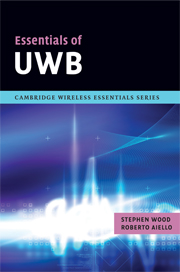Book contents
- Frontmatter
- Contents
- 1 Introducing ultra-wideband (UWB)
- 2 Matching UWB to HDR applications
- 3 Physical-layer (PHY) characteristics
- 4 Media-access control (MAC) layer
- 5 Implementation information
- 6 Upper-layer protocols
- 7 Ultra-wideband standardization
- 8 Special-interest groups
- 9 Ultra-wideband business issues
- 10 Regulating ultra-wideband
- 11 Tragedy of the commons
- Appendix: Reference documents
- Author biographies
- Index
- References
4 - Media-access control (MAC) layer
Published online by Cambridge University Press: 22 August 2009
- Frontmatter
- Contents
- 1 Introducing ultra-wideband (UWB)
- 2 Matching UWB to HDR applications
- 3 Physical-layer (PHY) characteristics
- 4 Media-access control (MAC) layer
- 5 Implementation information
- 6 Upper-layer protocols
- 7 Ultra-wideband standardization
- 8 Special-interest groups
- 9 Ultra-wideband business issues
- 10 Regulating ultra-wideband
- 11 Tragedy of the commons
- Appendix: Reference documents
- Author biographies
- Index
- References
Summary
As with the PHY in the previous chapter, this discussion of the MAC is intended to be somewhat cursory. The full detail can be found in the ECMA 368 standard.[1] As demonstrated in Figure 4.1, the MAC layer sits immediately above the PHY.
The media access control (MAC) layer of the radio connects to the service access point (SAP) on top of the physical layer. The PHY SAP is nothing more than the logical gateway through which data flow in a specified format from the MAC to the PHY and back again. When data need to be communicated from one device to another, they must begin at the top of one of the protocol stacks shown above (WUSB, Bluetooth, etc.) and flow down through each layer, out over the connecting media (RF or wire) and up through each of the layers of the equivalent stack in the radio to whom the communication is being sent. Each layer of the stack has a specific task to perform in making sure that the data are successfully transferred.
Where the PHY is responsible for going through the physical steps of placing bits onto the air during a transmission effort and taking them off again during a receive operation, the MAC is responsible for the first level of processing that takes place on data coming out of the PHY.
For instance, a radio channel, by its nature, is relatively unreliable.
- Type
- Chapter
- Information
- Essentials of UWB , pp. 48 - 65Publisher: Cambridge University PressPrint publication year: 2008



